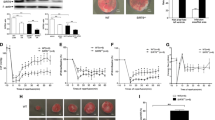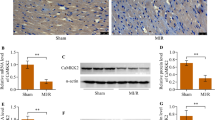Abstract
Although our previous studies have established the crucial role of RP105 in myocardial ischemia/reperfusion injury (MI/RI), its involvement in regulating oxidative stress induced by MI/RI remains unclear. To investigate this, we conducted experiments using a rat model of ischemia/reperfusion (I/R) injury. Adenovirus carrying RP105 was injected apically at multiple points, and after 72 h, the left anterior descending coronary artery was ligated for 30 min followed by 2 h of reperfusion. In vitro experiments were performed on H9C2 cells, which were transfected with recombinant adenoviral vectors for 48 h, subjected to 4 h of hypoxia, and then reoxygenated for 2 h. We measured oxidative stress markers, including superoxide dismutase (SOD) and glutathione peroxidase (GSH-Px) activities, as well as malondialdehyde (MDA) concentration, using a microplate reader. The fluorescence intensity of reactive oxygen species (ROS) in myocardial tissue was measured using a DHE probe. We also investigated the upstream and downstream components of the signal transducer and activator of transcription 3 (STAT3). Upregulation of RP105 increased SOD and GSH-Px activities, reduced MDA concentration, and inhibited ROS production in response to I/R injury in vivo and hypoxia reoxygenation (H/R) stimulation in vitro. The overexpression of RP105 led to a decrease in the myocardial enzyme LDH in serum and cell culture supernatant, as well as a reduction in infarct size. Additionally, left ventricular fraction (LVEF) and fractional shortening (LVFS) were improved in the RP105 overexpression group compared to the control. Upregulation of RP105 promoted the expression of Lyn and Syk and further activated STAT phosphorylation, which was blocked by PP2 (a Lyn inhibitor). Our findings suggest that RP105 can inhibit MI/RI-induced oxidative stress by activating STAT3 via the Lyn/Syk signaling pathway.






Similar content being viewed by others
DATA AVAILABILITY
No datasets were generated or analysed during the current study.
REFERENCES
Jin, T., J. Lin, Y. Gong, et al. 2021. iPLA2beta contributes to ER stress-induced apoptosis during myocardial ischemia/reperfusion injury. Cells 10 (6).
Wu, Y., H. Liu, and X. Wang. 2021. Cardioprotection of pharmacological postconditioning on myocardial ischemia/reperfusion injury. Life Sciences 264 (118628).
Liang, S., Z. Ping, and J. Ge. 2017. Coenzyme Q10 Regulates antioxidative stress and autophagy in acute myocardial ischemia-reperfusion injury. Oxidative Medicine and Cellular Longevity 2017 (9863181).
Qin, Q., L. Cui, Z. Zhou, et al. 2019. Inhibition of microRNA-141–3p reduces hypoxia-induced apoptosis in H9c2 rat cardiomyocytes by activating the RP105-dependent PI3K/AKT signaling pathway. Medical Science Monitor 25: 7016–7025.
Yang, J., C. Yang, J. Yang, et al. 2018. RP105 alleviates myocardial ischemia reperfusion injury via inhibiting TLR4/TRIF signaling pathways. International Journal of Molecular Medicine 41 (6): 3287–3295.
Yang, J., X. Guo, J. Yang, et al. 2015. RP105 protects against apoptosis in ischemia/reperfusion-induced myocardial damage in rats by suppressing TLR4-mediated signaling pathways. Cellular Physiology and Biochemistry 36 (6): 2137–2148.
Guo, X., H. Jiang, J. Yang, et al. 2016. Radioprotective 105 kDa protein attenuates ischemia/reperfusion-induced myocardial apoptosis and autophagy by inhibiting the activation of the TLR4/NF-kappaB signaling pathway in rats. International Journal of Molecular Medicine 38 (3): 885–893.
Zhang, Z., D. La Placa, T. Nguyen, et al. 2019. CEACAM1 regulates the IL-6 mediated fever response to LPS through the RP105 receptor in murine monocytes. BMC Immunology 20 (1): 7.
Yang, Y., C. Wang, P. Cheng, et al. 2018. CD180 ligation inhibits TLR7- and TLR9-mediated activation of macrophages and dendritic cells through the Lyn-SHP-1/2 axis in murine lupus. Frontiers in Immunology 9 (2643).
Dong, G., X. Yao, F. Yan, et al. 2019. Ligation of CD180 contributes to endotoxic shock by regulating the accumulation and immunosuppressive activity of myeloid-derived suppressor cells through STAT3. Biochimica et Biophysica Acta, Molecular Basis of Disease 1865 (3): 535–546.
Chun, K.S., J.H. Jang, and D.H. Kim. 2020. Perspectives regarding the intersections between STAT3 and oxidative metabolism in cancer. Cells 9 (10).
Xu, G., W. Zhang, Z. Wang, et al. 2020. Matrine regulates H2O2-induced oxidative stress through long non-coding RNA HOTAIR/miR-106b-5p axis via AKT and STAT3 pathways. Bioscience Reports 40 (5).
Lin, K.C., D.Y. Huang, D.W. Huang, et al. 2016. Inhibition of AMPK through Lyn-Syk-Akt enhances FcepsilonRI signal pathways for allergic response. Journal of Molecular Medicine (Berlin, Germany) 94 (2): 183–194.
Sanderson, M.P., E. Wex, T. Kono, et al. 2010. Syk and Lyn mediate distinct Syk phosphorylation events in FcvarepsilonRI-signal transduction: Implications for regulation of IgE-mediated degranulation. Molecular Immunology 48 (1–3): 171–178.
Yazawa, N., M. Fujimoto, S. Sato, et al. 2003. CD19 regulates innate immunity by the toll-like receptor RP105 signaling in B lymphocytes. Blood 102 (4): 1374–1380.
Zheng, T., J. Yang, J. Zhang, et al. 2021. Downregulated MicroRNA-327 attenuates oxidative stress-mediated myocardial ischemia reperfusion injury through regulating the FGF10/Akt/Nrf2 signaling pathway. Frontiers in Pharmacology 12 (669146).
Li, Q., J. Yang, J. Zhang, et al. 2020. Inhibition of microRNA-327 ameliorates ischemia/reperfusion injury-induced cardiomyocytes apoptosis through targeting apoptosis repressor with caspase recruitment domain. Journal of Cellular Physiology 235 (4): 3753–3767.
Aspey, B.S., F.L. Taylor, M. Terruli, et al. 2000. Temporary middle cerebral artery occlusion in the rat: Consistent protocol for a model of stroke and reperfusion. Neuropathology and Applied Neurobiology 26 (3): 232–242.
Xu, S., B. Wu, B. Zhong, et al. 2021. Naringenin alleviates myocardial ischemia/reperfusion injury by regulating the nuclear factor-erythroid factor 2-related factor 2 (Nrf2) /System xc-/ glutathione peroxidase 4 (GPX4) axis to inhibit ferroptosis. Bioengineered 12 (2): 10924–10934.
You, M., G. Dong, F. Li, et al. 2017. Ligation of CD180 inhibits IFN-alpha signaling in a Lyn-PI3K-BTK-dependent manner in B cells. Cellular & Molecular Immunology 14 (2): 192–202.
Xiang, M., Y. Lu, L. Xin, et al. 2021. Role of oxidative stress in reperfusion following myocardial ischemia and its treatments. Oxidative Medicine and Cellular Longevity 2021 (6614009).
Sinning, C., D. Westermann, and P. Clemmensen. 2017. Oxidative stress in ischemia and reperfusion: Current concepts, novel ideas and future perspectives. Biomarkers in Medicine 11 (11): 11031–11040.
Wang, S., Y. Chen, C. Wu, et al. 2023. Trehalose alleviates myocardial ischemia/reperfusion injury by inhibiting NLRP3-mediated pyroptosis. Applied Biochemistry and Biotechnology.
Xia, B., Q. Li, K. Zheng, et al. 2023. Down-regulation of Hrd1 protects against myocardial ischemia-reperfusion injury by regulating PPARα to prevent oxidative stress, endoplasmic reticulum stress, and cellular apoptosis. European Journal of Pharmacology 954 (175864).
Wang, S., Y. Cai, R. Bu, et al. 2023. PPARγ regulates macrophage polarization by inhibiting the JAK/STAT pathway and attenuates myocardial ischemia/reperfusion injury in vivo. Cell Biochemistry and Biophysics 81 (2): 349–358.
Qiu, L., X. Liu, W. Li, et al. 2021. Downregulation of p300/CBP-associated factor inhibits cardiomyocyte apoptosis via suppression of NF-kappaB pathway in ischaemia/reperfusion injury rats. Journal of Cellular and Molecular Medicine 25 (21): 10224–10235.
Wu, H., T. Xu, T. Chen, et al. 2022. Oxidative stress mediated by the TLR4/NOX2 signalling axis is involved in polystyrene microplastic-induced uterine fibrosis in mice. The Science of the Total Environment 838 (Pt 2): 155825.
Wang, B., L. Chen, L. Dai, et al. 2019. Alisol B 23-acetate ameliorates lipopolysaccharide-induced cardiac dysfunction by suppressing toll-like receptor 4 (TLR4)/NADPH oxidase 2 (NOX2) signaling pathway. Medical Science Monitor 25: 8472–8481.
Wang, W., S. Bale, B. Yalavarthi, et al. 2022. Deficiency of inhibitory TLR4 homolog RP105 exacerbates fibrosis. JCI Insight 7 (21).
Chen, X., H. Pan, J. Li, et al. 2019. Inhibition of myeloid differentiation 1 specifically in colon with antisense oligonucleotide exacerbates dextran sodium sulfate-induced colitis. Journal of Cellular Biochemistry 120 (10): 16888–16899.
Erdo-Bonyar, S., J. Rapp, T. Minier, et al. 2019. Toll-like receptor mediated activation of natural autoantibody producing B cell subpopulations in an autoimmune disease model. International Journal of Molecular Sciences 20 (24).
Koarada, S., and Y. Tada. 2012. RP105-negative B cells in systemic lupus erythematosus. Clinical and Developmental Immunology 2012 (259186).
Fan, Z., J.L. Pathak, and L. Ge. 2021. The potential role of RP105 in regulation of inflammation and osteoclastogenesis during inflammatory diseases. Frontiers in Cell and Developmental Biology 9 (713254).
Yang, Y., J. Yang, X.W. Liu, et al. 2018. Down-regulation of miR-327 alleviates ischemia/reperfusion-induced myocardial damage by targeting RP105. Cellular Physiology and Biochemistry 49 (3): 1049–1063.
Huang, W., J. Yang, C. He, et al. 2020. RP105 plays a cardioprotective role in myocardial ischemia reperfusion injury by regulating the Tolllike receptor 2/4 signaling pathways. Molecular Medicine Reports 22 (2): 1373–1381.
Yamazaki, T., M. Biswas, K. Kosugi, et al. 2020. A novel gene delivery vector of agonistic anti-radioprotective 105 expressed on cell membranes shows adjuvant effect for DNA immunization against influenza. Frontiers in Immunology 11 (606518).
Hao, J.W., J. Wang, H. Guo, et al. 2020. CD36 facilitates fatty acid uptake by dynamic palmitoylation-regulated endocytosis. Nature Communications 11 (1): 4765.
Fathi, N.N., D.K. Mohammad, A. Gorgens, et al. 2018. Translocation-generated ITK-FER and ITK-SYK fusions induce STAT3 phosphorylation and CD69 expression. Biochemical and Biophysical Research Communications 504 (4): 749–752.
Uckun, F.M., S. Qazi, H. Ma, et al. 2010. STAT3 is a substrate of SYK tyrosine kinase in B-lineage leukemia/lymphoma cells exposed to oxidative stress. Proceedings of the National Academy of Sciences USA 107 (7): 2902–2907.
O’Sullivan, K.E., E.P. Breen, H.C. Gallagher, et al. 2016. Understanding STAT3 signaling in cardiac ischemia. Basic Research in Cardiology 111 (3): 27.
Pace, J., P. Paladugu, B. Das, et al. 2019. Targeting STAT3 signaling in kidney disease. American Journal of Physiology. Renal Physiology 316 (6): F1151–F1161.
Butturini, E., A. Carcereri de Prati, and S. Mariotto. 2020. Redox regulation of STAT1 and STAT3 signaling. International Journal of Molecular Sciences 21 (19).
Guo, H.H., X.Y. Jing, H. Chen, et al. 2021. STAT3 but not STAT5 contributes to the protective effect of electroacupuncture against myocardial ischemia/reperfusion injury in mice. Frontiers in Medicine (Lausanne) 8 (649654).
Harhous, Z., S. Badawi, N.G. Bona, et al. 2019. Critical appraisal of STAT3 pattern in adult cardiomyocytes. Journal of Molecular and Cellular Cardiology 131: 91–100.
Nikolaou, P.E., P. Efentakis, F. Abu Qourah, et al. 2021. Chronic empagliflozin treatment reduces myocardial infarct size in nondiabetic mice through STAT-3-mediated protection on microvascular endothelial cells and reduction of oxidative stress. Antioxidants & Redox Signaling 34 (7): 551–571.
Yin, Q., B. Zhao, J. Zhu, et al. 2020. JLX001 improves myocardial ischemia-reperfusion injury by activating Jak2-Stat3 pathway. Life Sciences 257 (118083).
Lan, H., Y. Su, Y. Liu, et al. 2019. Melatonin protects circulatory death heart from ischemia/reperfusion injury via the JAK2/STAT3 signalling pathway. Life Sciences 228: 35–46.
Funding
The research described in this article was supported by the following grants: National Natural Science Foundation of China (82070372, 82170418, 82271618), Hubei Province’s Outstanding Medical Academic Leader Program; Natural Science Foundation of Hubei Province (2022CFA015); Science and Technology Innovation Platform of Hubei Province (2022DCC014); Key Research and Development Program of Hubei Province (2022BCE001); Hubei Provincial Health Commission Project (WJ2023M151); and Research Fund for Excellent Dissertation of China Three Gorges University (2021SSPY101).
Author information
Authors and Affiliations
Contributions
Y.J, Z.YH. and H.CY. as co-first authors and were primarily responsible for analyzing the data and drafting the manuscript. Y.J. contributed ideas and designed the experimental process, while Z.J. guided the experimental operation and problem-solving. X.ZJ., L.HY., W.JY., H.YF., L.L., L.WQ., W.W. conducted the animal and cell experiments. All authors reviewed the manuscript.
Corresponding authors
Ethics declarations
Ethics Approval and Consent to Participate
This experiment was approved by the animal ethics committee of China Three Gorges University (NO.202205010W).
Consent for Publication
Not applicable.
Competing Interests
The authors declare no competing interests.
Additional information
Publisher's Note
Springer Nature remains neutral with regard to jurisdictional claims in published maps and institutional affiliations.
SUPPLEMENTARY INFORMATION
Below is the link to the electronic supplementary material.
Rights and permissions
Springer Nature or its licensor (e.g. a society or other partner) holds exclusive rights to this article under a publishing agreement with the author(s) or other rightsholder(s); author self-archiving of the accepted manuscript version of this article is solely governed by the terms of such publishing agreement and applicable law.
About this article
Cite this article
Yang, J., Zhai, Y., Huang, C. et al. RP105 Attenuates Ischemia/Reperfusion-Induced Oxidative Stress in the Myocardium via Activation of the Lyn/Syk/STAT3 Signaling Pathway. Inflammation (2024). https://doi.org/10.1007/s10753-024-01982-y
Received:
Revised:
Accepted:
Published:
DOI: https://doi.org/10.1007/s10753-024-01982-y




